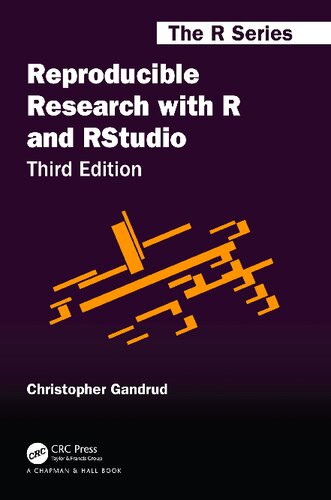

Most ebook files are in PDF format, so you can easily read them using various software such as Foxit Reader or directly on the Google Chrome browser.
Some ebook files are released by publishers in other formats such as .awz, .mobi, .epub, .fb2, etc. You may need to install specific software to read these formats on mobile/PC, such as Calibre.
Please read the tutorial at this link: https://ebookbell.com/faq
We offer FREE conversion to the popular formats you request; however, this may take some time. Therefore, right after payment, please email us, and we will try to provide the service as quickly as possible.
For some exceptional file formats or broken links (if any), please refrain from opening any disputes. Instead, email us first, and we will try to assist within a maximum of 6 hours.
EbookBell Team

4.4
62 reviewsPraise
for previous editions:
"Gandrud
has written a great outline of how a fully reproducible research project
should look from start to finish, with brief explanations of each tool that he
uses along the way… Advanced undergraduate students in mathematics, statistics,
and similar fields as well as students just beginning their graduate studies
would benefit the most from reading this book. Many more experienced R users or
second-year graduate students might find themselves thinking, ‘I wish I’d read
this book at the start of my studies, when I was first learning R!’…This book
could be used as the main text for a class on reproducible research …" (The
American Statistician)
Reproducible
Research with R and R Studio, Third Edition brings together the skills and tools needed for
doing and presenting computational research. Using straightforward examples,
the book takes you through an entire reproducible research workflow. This
practical workflow enables you to gather and analyze data as well as
dynamically present results in print and on the web. Supplementary materials
and example are available on the author’s website.
New to
the Third Edition
■Updated package recommendations,
examples, URLs, and removed technologies no longer in regular use.
■More advanced R Markdown (and less
LaTeX) in discussions of markup languages and examples.
■Stronger focus on reproducible
working directory tools.
■Updated discussion of cloud storage
services and persistent reproducible material citation.
■Added discussion of Jupyter
notebooks and reproducible practices in industry.
■Examples of data manipulation with
Tidyverse tibbles (in addition to standard data frames) and pivot_longer() and
pivot_wider() functions for pivoting data.
Features
■Incorporates the most important
advances that have been developed since the editions were published
■Describes a complete reproducible
research workflow, from data gathering to the presentation of results
■Shows how to automatically generate
tables and figures using R
■Includes instructions on formatting
a presentation document via markup languages
■Discusses cloud storage and
versioning services, particularly Github
■Explains how to use Unix-like shell
programs for working with large research projects